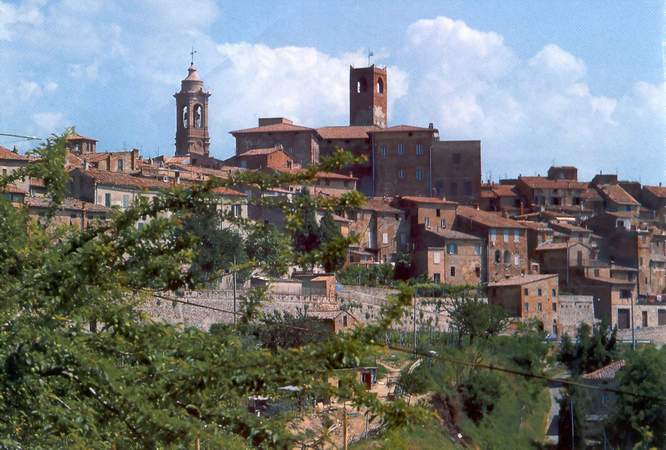When I told an American friend of mine two years ago that I was visiting Sicily she said "You can't leave Sicily without visiting the Palazzo Biscari in Catania - I spent several years of my life studying that place and it's a must!!" Having just completed a Masters thesis on it she had all the info on how to go about doing just that.
 |
| VIA MUSEO BISCARI - CATANIA Just one street back from the seafront |
 |
| THE GRAND BAROQUE ENTRANCE TO THE PALAZZO BISCARI Above the arch are the arms of the Biscari family |
On one of the days we spent in Catania itself we walked down the grubby Via Museo Biscari to find the palazzo. The entrance was a huge and monumental structure with huge pair of intimidating wooden doors giving no indication of what could be found within. My friend had told me to ring the bell which I did and after a couple of minutes one of the two doors creaked open a fraction and an elderly gentleman who turned out to be the gatekeeper, asked us our business in Italian - it was soon apparent he spoke no English. The next few moments involved a laboured effort on my part to explain what we wanted. Eventually he managed to tell me I needed to ring Prince Roger, the current Prince Biscari and he soon thrust a grubby piece of paper in my hand with a scrawled telephone number on it. Full of trepidation I used my mobile phone to ring the number and it was quickly picked up by no other than Prince Biscari himself; he spoke excellent English. "Ah - you want to come on a special guided tour given by me" he said - "Come back at 11am and I'll show you round!". What a treat was in store - a private tour of a famous palazzo with a real life Sicilian Prince!!
 |
| THE COURTYARD OF THE PALAZZO BISCARI The flight of steps is the main entrance to the state rooms of the Palazzo |
Prince Biscari turned out to be a genial, not in the least bit intimidating Sicilian gentleman in his 50's keen and enthusiastic to welcome us to Palazzo Biscari. Part of just a very small group of visitors we began our tour in the wonderfully atmospheric if a little delapidated palazzo courtyard so typical of Italian grand houses and it was there that the Prince gave us a potted history of this grand place.
 |
| ROGER - PRINCE BISCARI Our Palazzo Guide |
Before the 1693 earthquake, which devastated much of Catania, there had existed here a palazzo belonging to the Paterno Castello family headed by Principi di Biscari. This was so badly damaged by the quake that it had to be demolished soon after the earthquake. As the rebuild of Catania began, a few aristocratic families, including the Castello family, were given permission to rebuild their homes. In this case the granting allowed the owner to use part of the old city walls which had survived the quake to be used as foundations for the new house. Work began in 1702 under the supervision of Vencenzo Biscari - the 4th Prince, who was only 17 years old. Keen to make his mark and re-establish his family's place in Catanian society, he had plans drawn up in the newly fashionable Italian Baroque style. The initial work would then be followed up and further enhanced by his nephew, Ignazio Paterno Castello who became 5th Prince when his Uncle died in 1744. A cultured and artistic man he was enthusiastic about the popular Rococo interior decoration style, so as well as adding a new apartment to the palazzo for himself and his new bride, he decorated some of the principal reception rooms in this taste. These decorative schemes survive to this day. So - as with many Sicilian buildings of this type, the end result, completed in 1763, is a splendid confection of various architectural and interior decoration elements woven together to produce something unique and splendid. Here are a few of the photographs I took on the visit with captions.
 |
| HERE, ON THE SEAWARD SIDE, IT'S POSSIBLE TO SEE HOW PART OF THE PALAZZO SITS ON TOP OF THE OLD CITY WALL |
 |
| THE BAROQUE SCULPTURES FORM THE FRAMES TO THE DOORWAYS WHICH GIVE ACCESS TO THE TERRACE ON TOP OF THE CITY WALLS |
 |
| BAROQUE PILASTER DETAIL |
 |
| THE SALONA DE BALLO (BALLROOM) |
 |
| VAULTED BALLROOM CEILING IN TYPICAL ROCOCO STYLE THE FRESCOED CUPOLA DEPICTS THE GLORY OF THE BISCARI FAMILY |
 |
| PART OF THE PRIVATE APARTMENT CREATED BY IGNAZIO FOR HIMSELF AND HIS NEW WIFE |
 |
| PRINCE ROGER DISCUSSES HIS FAMILY HISTORY |
 |
| MY PARTNER JON CONTEMPLATES WORKS OF ART IN THE PALAZZO |
If you visit Catania and want to see the Palazzo Biscari - to gain access try what I did and seek out the gateway concierge. I believe the palazzo is only open to private groups. It is also used for functions like marriages and other celebratory parties.













